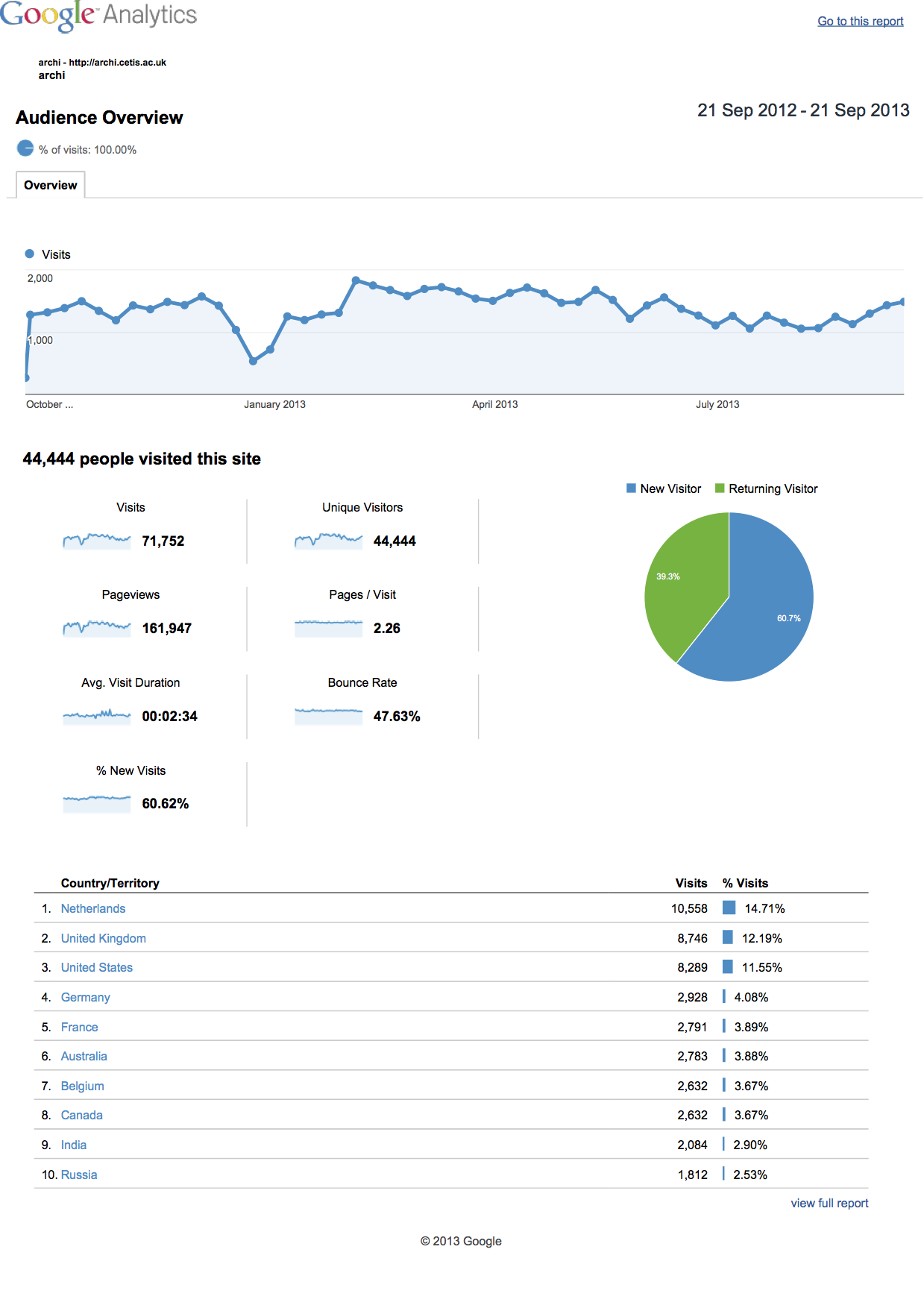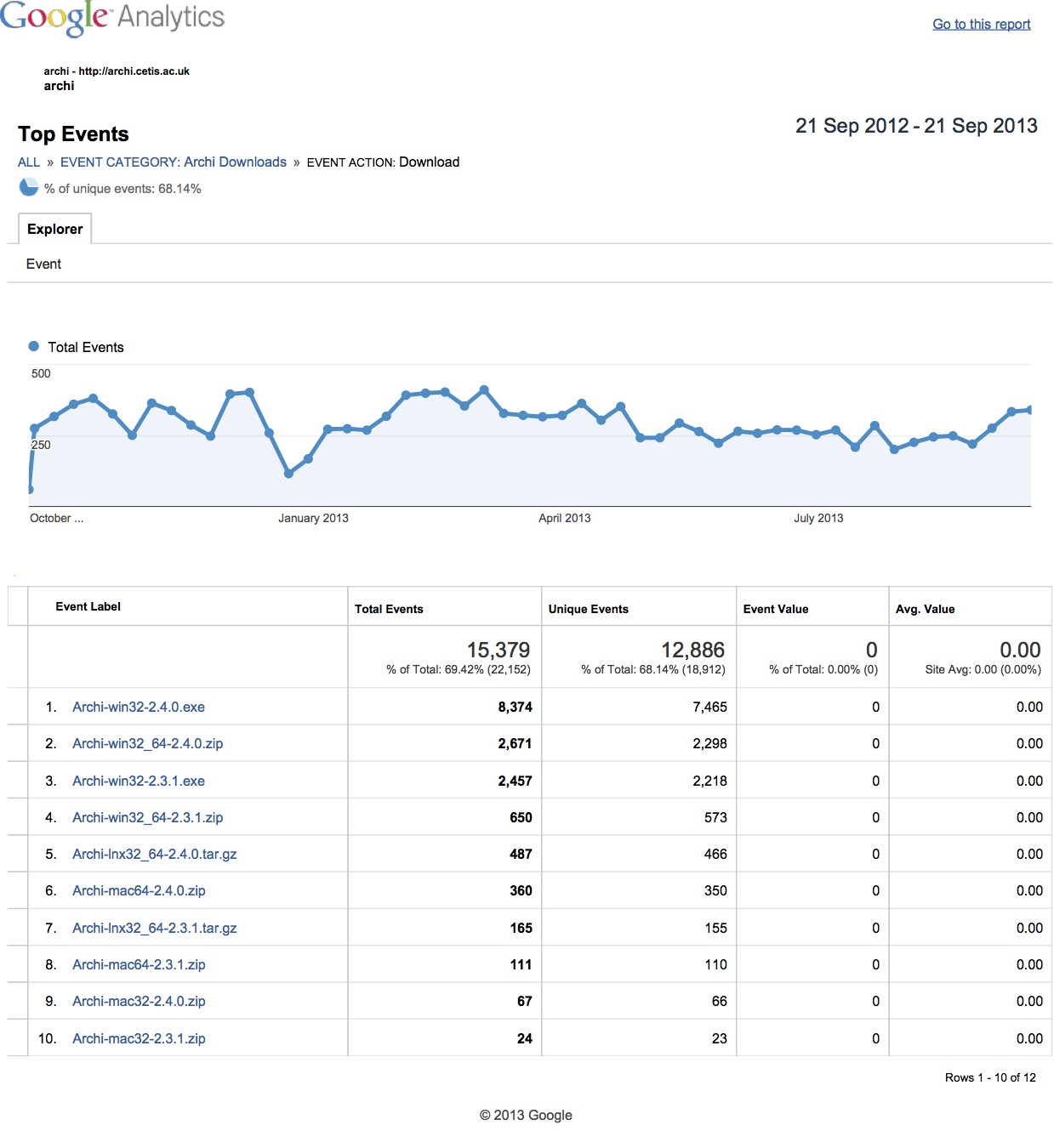(Continued from Part 3)
Impact and Popularity
In this final blog post in the series, I want to examine the impact and popularity of the Archi tool.
Archi 2.4 was released in December 2012. In the previous two years of development I had implemented a fairly respectable feature set, and devised some unique features, thanks to a source of funding that paid my wages, and the feedback and enthusiasm of Archi’s users.

Just how popular has Archi been? And how popular is Archi right now? I suspect that it has been, and still is, very popular.
In 2011, Christina Smart, from a Jisc-funded organisation, interviewed me for a blog post, Business Adopts Archi Modelling Tool, and I spoke of the possible reasons for the extensive adoption of Archi, especially in the business sector:
CS: Archi has a growing number of users outside education, who are they and how did they discover Archi?
PB: …I am also aware of other commercial companies using [Archi], but how did they discover it? Well I think it’s been viral. A lot of businesses spend a lot of money advertising and pushing products, but the alternate strategy is “pull”, when customers come to you. Archi is of the pull variety, because there is a need out there, we haven’t had to do very much marketing, people seem to have found Archi on their own. Also the TOGAF (The Open Group Architecture Framework) developed by the Open Group is becoming very popular and I guess Archi is useful for people adopting TOGAF.CS: Why do you think it is so popular with business users?
PB: I’m end-user driven, for me Archi is about the experience of the end users, ensuring that the experience is first class and that it “just works”. It’s popular with business users firstly because it’s free, secondly because it works on all platforms, thirdly because it’s aimed at those making their first steps with ArchiMate.
When I spoke about the concept of “pull”, I was referring to the book, The Power of Pull, by John Hagel. Tom Graves, the author, Enterprise Architect, “business anarchist”, and self-proclaimed “confusionist”, once said to me, in a telephone conversation, that he thought that Archi’s popularity was due, partly, to this “power of pull”. Archi had no advertising budget, it had no pushy salesmen, nor was it ever promoted in any significant way. Instead, users discovered it by word-of-mouth, by a friendly recommendation, or via a simple Google search. Together with an agile feedback loop between developer and users, popularity increased. Users clearly liked the whole package – both the developer and the product.
This is not rocket science. For me, this approach comes easily and naturally. I only have to think of the products and websites that I like, and think about why I like them, and just do the same. The key is to be open, clear and honest. People will come to you. I’m not a big fan of websites that claim to be selling a software product but where you have no idea what the software does, how to download it, how much it costs, or what it looks like. Instead you get a series of stuffy “white papers” explaining the benefits of nebulous “solutions” written in MBA sound-bites. Nor did I employ the “push and grab” approach – flooding the twitter-verse with tweets telling us of the “Top reasons to get a grip on the latest #archimate and #togaf trends!!!! Read our new white paper!” I know where “white paper” belongs in my household...
If you look at the front page of the Archi website it’s immediately clear what Archi is, does, how much it costs (nothing), what it looks like (screenshots), and where to download it:
Archi is a free, open source, cross-platform tool and editor to create ArchiMate models.
And I strongly believe that even the largest of organisations can relate to this honest, no-nonsense approach. That’s why I call myself a “code punk”. The software may only play three chords, but they’re honest and powerful ones.
Statistics and Google Analytics
I think we can get a sense of this popularity by looking at some statistics for that period. The old Archi website (no longer maintained), was tracked by Google Analytics. First off, let’s take a look at the figures for the year previous to when this blog post was written (September 21 2012 to September 21, 2013):

Here we can see that in this yearly period, there were 71,752 visits to the website, of which 44,444 were unique visitors. Taking the unique visits alone, that’s about 3700 a month, or about 850 a week. Not bad. We can also see that a large proportion of visits (10,558) came from the Netherlands. This is not surprising given that ArchiMate is, as well as cheese and tulips, a Dutch product. The UK and the US follow closely behind. Here’s another view of the demographic location data:

It’s interesting that India and Russia are in the top 10. Russia has a thriving community of Archi users, perhaps due to the fact that it was translated into Russian by Anatoly Levenchuk from Moscow. Again, this is an example of how the Archi community has contributed significantly toward its success.
Software Downloads
But what about the download numbers of the actual software?

Let’s take the figures for Archi version 2.4.0. Here we need to make some adjustments because Archi 2.4.0 was released in December 2012, and this reporting period starts from September 2012 (hence the figures for Archi 2.3.1). Therefore, this represents about 9 months for Archi 2.4.0. Adding up the numbers for the Windows executable (8,374), the Windows zip install (2,671), the Linux version (487), the Mac 64-bit version (360) and the Mac 32-bit version (67) we get a grand total of 11,959 downloads of Archi over a 9-month period. That’s about 1300 downloads a month.
It seems a lot. We could knock off a percentage for duplicate and failed downloads. But then again, these figures only show who actually clicked on a download link on the downloads page. There are probably direct downloads linked from other pages and referrals. Also, some organisations that I know of roll out only one centralised copy of the software throughout the company, so this might only show as one download, or not show at all if they have a direct link.
However you interpret these figures, I feel confident in thinking that Archi is probably the most popular ArchiMate modelling tool. Of course, this assumption is based on these download figures and the many emails I’ve received over the last three years. Put it this way, there are a couple of Fortune 500 companies that I know of, and some very large organisations that use Archi as their only ArchiMate modelling tool. I believe also that a couple of large training organisations use it as their training tool. Given that it was only meant to be a “starter” application, I find that interesting.
Archi has come a long way since its initial incarnation as a “proof of concept” tool.
Futures
Where now for Archi? I no longer work for the organisation that hosted the original development work on Archi and it’s time to move on! Also, Eclipse, the software framework on which Archi is built, has changed radically with the latest version 4, and this introduces some new challenges which need to be solved. The answer lies in the fact that the software is open source. All of the code can be found at GitHub, and is released with a MIT-type licence. If Archi is to be sustained, it will need to be migrated to Eclipse 4, and it needs to implement some of the most requested features from its hundreds of users. This will require the input of other developers, and so the next step is to get more developers on board.
I’d like to say thanks to all Archi’s users and supporters, for playing their part and allowing it to happen. It was, and is, I think, a success. With around 1000 2000 3000 downloads each month I’d say that Archi is quite popular.
Update 4 October 2013 – I’ve created a new and supported Archi website at https://www.archimatetool.com
Update 11 March 2014 -We are now seeing around 3000 downloads a month of the latest version of Archi at https://www.archimatetool.com. Since I set up this new website, Archi’s popularity and reputation has doubled and we’ve also attracted some additional developer interest.
